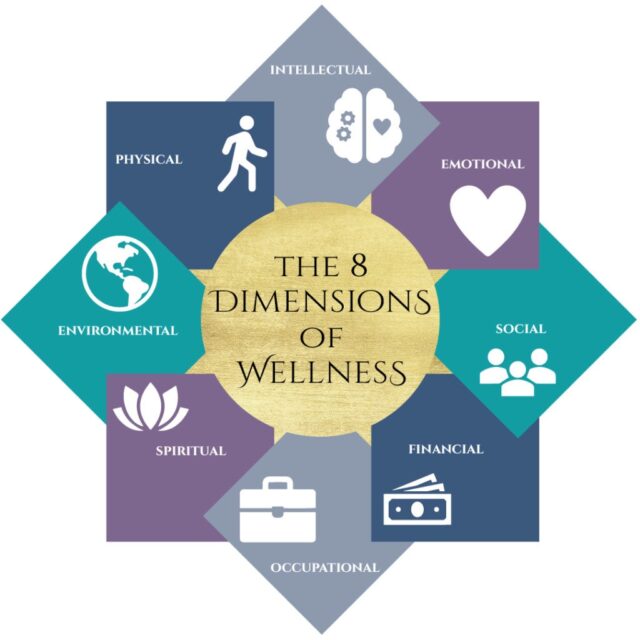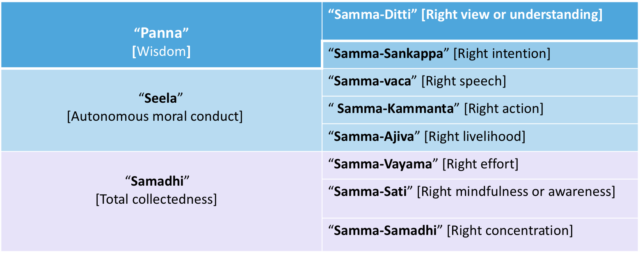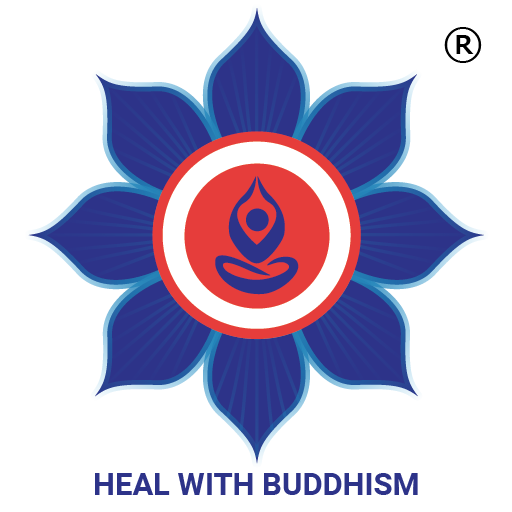As I mentioned in my last blog article, there has been a growing misconception around the purpose of dhamma as a religious faith exclusive to those who wish to reach the state of Nibbhāna.
It is true that Buddhism teaches us the path to Nibbhāna [the supreme state of mind that is liberated from ignorance and greed] because “Sammā Sambuddha” is the only one that is capable of guiding us towards it.
However, many including Buddhist followers have forgotten the following important facts about Buddha & his teachings:
# Buddha’s teachings has always been open to anyone and everyone with or without the intention to reach Nibbhāna:
Following examples are only a few of many individuals who visited Lord Buddha the Gautama with many different intentions, yet end up following the same eight-fold-middle path that brought them contentment in their lives:
- Śāriputra & Moggallāna, the chief disciples of Lord Buddha the Gautama initially visited him because they were curious about “the cause & effect phenomena ”.
- Prince Rāhula, followed his dad [ Lord Buddha the Gautama] at the age of 7 to seek his heritage as per the recommendation of his mother [ Prince Yashodara].
- Prince Nanda, followed his half-brother [ Lord Buddha the Gautama] with the intention to reach heaven in order to have an angel as his wife.
- Anāthapiṇḍika, the wealthiest merchant of Buddha’s time came to see Buddha because he was curious to learn about the teachings of enlightened one.
- Kāla, the son of Anāthapiṇḍika came to see Lord Buddha the Gautama because his father offered him 1000 gold coins if he were to learn and repeat a sutra from Buddha.
- Visakha, the chief female disciple or the chief benefactress of Lord Buddha the Gautama visited him at the age of 7 with her family as a child with no intention of becoming “Sotāpanna” [enter the first noble stage of enlightenment] at such young age.
- Paṭācārā, a young female who lost her children, husband, parents & siblings within a day came across Lord Buddha the Gautama while she was loitering around with no hope for her life.
- Aṅgulimāla, met Lord Buddha the Gautama while been manipulated to collect 1000 human finger tips as a gift for his teacher.
- Āmrapālī, the royal courtesan known for her exceptional beauty became a follower of Lord Buddha the Gautama due to the kindness and protection she received within the teachings.
# Lord Buddha the Gautama was an influential leader and an inclusive teacher who not only lead others by example but also guided and supported them through social remodelling.
It would be unfortunate if we were to forget that Lord Buddha the Gautama spend 45 yrs of his Buddhahood creating a society that supports eight dimensions to wellness through the practice of eightfold middle path. One could assume that it must have been due to his awareness/understanding around the challenges of an unhealthy, unhappy, unsafe & unfair society, which would hinder individuals’ ability to achieve their best regardless of their best effort.
Dhamma Pada 204 is one of the best examples that highlight the interconnection between the eight dimensions to wellness that is required to maintain a sustainable society that is healthy, happy, safe and fair.

Arōgyā paramā lābhā
Santuṭṭhi paramaṃ dhanaṃ
Vissāsa paramā ñāti
Nibbānaṃ paramaṃ sukhaṃ
King Pasenadi Kosala, King Ajātasattu and Emperor Aśoka are only a few examples of powerful rulers influences by Buddhist teachings to govern with Dasavidha-rājadhamma (“tenfold virtue of the ruler”) rather than rule, which supported them in creating a safe & fair society for every one regardless of their faith, gender or social status.
# Buddhism is not about reaching a final destination but it is about why [our intentions], how [our approach/ method] and how determined [our effort] we are to reach permanent contentment while temporarily being content with each moment of our journey.
Though there is so.. much talk about contentment in the modern society, many seems to bring confusion than clarity around its’ real meaning and how to achieve it practically.
But on the other hand, Buddhist teachings of eight-fold-middle path seems to provide much more clarity while guiding us towards a lifestyle, which not only help us create a sustainable society but also help us achieve two kinds of contentment:
One is the permanent contentment that can only be experience by an individual who has reached the state of enlightenment [ state of mind that has permanently eradicated greed & ignorance].
Second is the temporarily contentment that is subject to impermanence and uncontrollability. We must not misunderstand this as being satisfied with everything that comes our way. Because, Buddhist path to achive contentment in life is not about settling for the least or bare minimum. It is about putting our best effort to achieve our best through “seela” “samādhi” & “pannā”:

Pannā
– Right Understanding:
Who we are and what we achieve are just a piece of a bigger puzzle. Unfortunately, we cannot isolate ourselves from the universal truth of “cause & effect phenomena” that is governed by five intercepting natural laws called “niyāma dhamma”, which may produce unpapered outcomes for very similar efforts.
Like everything else in life what we achieve in life including contentment are subject to impermanence & uncontrollability.
– Right Intention:
There is no limit to our desire. More we achieve, more we desire for. Yet, Buddhism doesn’t suggest individuals to stop desiring for more because it is how we are wired. However, what Buddha suggests is to analyse and project your desires towards goals that not only benefit yourself but also others.
Seela
It seems like that our ancestors were much more practical about being content than us modern dwellers, because following autonomous moral conduct is about being satisfied with who you are and what you have while creating a safe and protective environment for others.
Samādhi
As we all know, practice is what makes us best in whatever we do. “Vipassanā” [the meditation taught in Buddhism] is about practicing how to analyse, while understanding the reality, so it can help us being content through our journey in this life and beyond.
# “Nibbhāna” is not another temporarily goal that can be achieved through another rat race, but a reality that can only be observed by an individual’s mind that has reached a permanent state of contentment with eternal peace and happiness through permanent eradication of greed and ignorance.
According to the Buddha’s teachings it is a supreme state of mind where one would come in to the realisation that there is no I, myself or mine, which is a concept that is difficult for many of us to grasp.
In order for us to understand this concept, we must first slow down to understand the following:
In “Abhidammā”, world we live in is divided in to two versions. One is known as “Paramatta sacca” [ultimate truth/ reality], the world that really exist and the other known as “Sammuti sacca” [conventional truth/reality], the world we believe to exist.
“Paramatta sacca” or the ultimate reality is then divided in to two sectors known as “saṅkhata dammā” [conditional truth] & “asaṅkhata dammā” [unconditional truths] where the latter is consist of “Nibbhāna” while the former consist of “nāma” [mental phenomena] and rūpa [physical phenomena].
Following could be considered as the major difference between the unconditional and conditional truths:
- “Nibbhāna” is a reality that can only be uncovered and observed by individuals who has reached the state of enlightenment [ state of mind that has permanently eradicated greed & ignorance].
- “Nāma” [mental phenomena] and rūpa [physical phenomena] are impermanent and uncontrollable realities that can be perceived by all while existing under the “cause & effect phenomena.
I would like to share the “Jātaka Katā” [story] of Gautama Buddha who fed a hungry tigress as a “bodhisattvā”, which is one of the best stories among many that highlights the depth of selflessness, kindness and compassion embedded in those attaining “Nibbhāna”.
Stay tuned with us to learn more about being content through Buddhist mindfulness.

